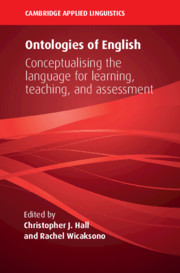Book contents
- Ontologies of English
- The Cambridge Applied Linguistics Series
- Ontologies of English
- Copyright page
- Dedication
- Contents
- Figures
- Tables
- Contributors
- Series Editors’ Preface
- Acknowledgements
- Transcription Conventions
- Part I Introduction
- Part II English in/for L2 Learning and Teaching
- Part III English in Schools
- Part IV Assessing English
- Part V English in Lingua Franca Contexts
- 12 What Is English in the Light of Lingua Franca Usage?
- 13 English as a Lingua Franca and Transcultural Communication
- 14 Exploring Standards-Based, Intelligibility-Based, and Complex Conceptions of English in a Lingua Franca Context
- Part VI English and Social Practice
- Part VII Commentary and Conclusions
- Index
- References
12 - What Is English in the Light of Lingua Franca Usage?
from Part V - English in Lingua Franca Contexts
Published online by Cambridge University Press: 24 December 2019
- Ontologies of English
- The Cambridge Applied Linguistics Series
- Ontologies of English
- Copyright page
- Dedication
- Contents
- Figures
- Tables
- Contributors
- Series Editors’ Preface
- Acknowledgements
- Transcription Conventions
- Part I Introduction
- Part II English in/for L2 Learning and Teaching
- Part III English in Schools
- Part IV Assessing English
- Part V English in Lingua Franca Contexts
- 12 What Is English in the Light of Lingua Franca Usage?
- 13 English as a Lingua Franca and Transcultural Communication
- 14 Exploring Standards-Based, Intelligibility-Based, and Complex Conceptions of English in a Lingua Franca Context
- Part VI English and Social Practice
- Part VII Commentary and Conclusions
- Index
- References
Summary
The origin of the term ‘lingua franca’ is unclear. According to Ostler (2010, p. 7), lingua franca “seems to be a retranslation of some Eastern-Mediterranean term for ‘language of the Franks’”. Ostler also notes (2010, p. 4) the “original ‘Lingua Franca’ was once a particular language … the common contact language of the Eastern-Mediterranean in the first half of the second millennium, the pidgin Italian in which Greeks and Turks could talk to Frenchmen and Italians”. He defines a lingua franca as a “contact language used for communication among people who do not share a mother tongue” (2010, p. 36). Seidlhofer points out that the term has Latin roots meaning something like ‘free language’. “It is thus not fanciful to think of ‘Lingua Franca’ as ‘free language’ … a means of intercultural communication not particular to countries and ethnicities, a linguistic resource that is not contained in, or constrained by traditional (and notoriously tendentious) ideas of what constitutes a ‘language’” (2011, p. 81).
Keywords
- Type
- Chapter
- Information
- Ontologies of EnglishConceptualising the Language for Learning, Teaching, and Assessment, pp. 233 - 252Publisher: Cambridge University PressPrint publication year: 2020
References
- 10
- Cited by

